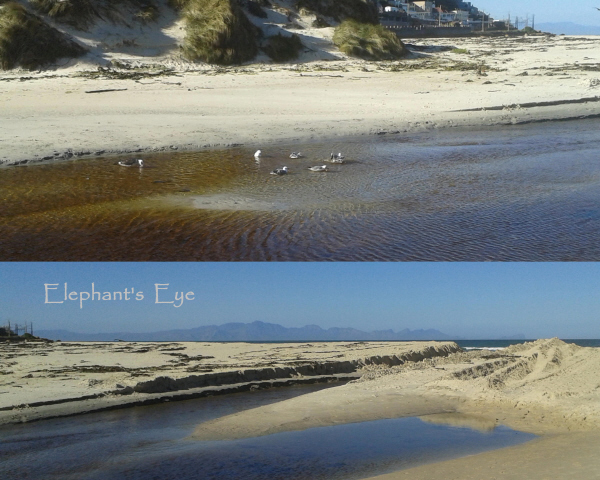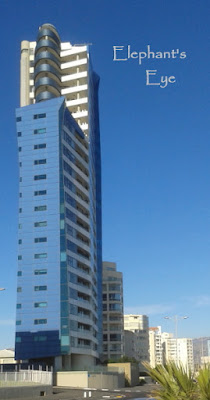Crossing False Bay
by Diana Studer
- gardening for biodiversity
in Cape Town, South Africa
The pictures of False Bay I've used on my blog have all
looked out to open sea. I love that wide, open, view. But it doesn't show the
bay, the mountains across the sea on the far shore. Last Sunday we walked beyond
our beach towards Simon's
Town, sat looking across our little bay to St James. Mid view is Cape Town's
winter smog, rolling across from the Cape Flats which divide the Cape Peninsula
from the Rest of Africa. In the far distance across False Bay are the
Hottentots Holland Mountains.
Walking back along the beach we turned back when we reached the Silvermine River, its mouth bulldozed open to the sea, releasing 'slightly' polluted water from the wetland. A group of seagulls were splashing around enjoying salt and fresh water in the estuary.
Deep water starfish, which usually live 100 metres deep on
the reef eating mussels, came into shore to spawn and were trapped by rough
weather. They could also be reacting to acidification
of the sea due to global weirding. Smashed against the rocks they lost some
legs (which do grow again, given half a chance). Friends
of the stars rescued 500 starfish. After they had recovered in the tidal
pool, they were returned to their home on World Oceans Day.
We crossed the bay to hunt for two chairs for our living
room. Factory visit sorted we went to Strand. Belgian waffles and pancakes for
lunch, then a gentle stroll along the prom on a perfect winter day. Cape Town
at its finest! For a Seasonal Celebration with Donna in NY State and Northern summers.
Looking along the coast to Cape Hangklip which lies at the
landlocked end of False Bay.
The sleepy hollow I remember as a child, now has modern
architecture. Topaz is a block of flats that looks as if it has just landed
from Dubai.
Walking back from the beach, I look out for interesting
gardens. We happened to walk past as this artist was adding the next set of
pebbles to his garden art.
When we turn the corner for home, this bead
and wire sheep greets us. On those wintry days with snow
on the mountain, he wore a purple scarf. When it rains he is tucked up
inside!
I am longing to walk on the mountain and see the flowers
coming thru after the March fire, but it is
firmly closed with barbed wire, warning notices and threats of fines. This
is the finely focused chance for seeds and bulbs before shrubs shade and crowd them
back into waiting patiently, for
the next fire. It is not just about avoiding stomping on the delicate green
sprouts you CAN see, but about the ones bravely coming up just below the
surface. We've also been asked to leave the wildlife
to recover in peace with what food and shelter is available to them.
Protea
seed heads burst open after fire to shed their seeds and make the most of
the winter rains. Standing cautiously next to the heavy traffic roaring along
the Ou
Kaapse Weg, this is a glimpse of an orange Watsonia. There were red fire lilies, some ethereal wild Gladiolus and a sprinkle of pink Oxalis. Protea bushes that escaped the flames are covered in flowers.
 |
| Watsonia blooming in Silvermine after the fire |
Pictures by Diana Studer
of Elephant's Eye on False Bay
(If you mouse over teal blue text, it turns seaweed red.
Those are my links.
To read or leave comments, either click the word Comments below,
or click this post's title)










I was wondering if the seed heads need the fire to release their seeds,,,
ReplyDeletethat sheep is amazing creation,,
I had never known this about starfish and its great to know there are rescuers in place to help them,,
its such a beautiful area you live in, I would never ever get to know your country as well without you as a friend, I truly am thankful for that,
Thanks so much for the wonderful tour of more of your beautiful area. So happy to see the starfish rescued. xo Laura
ReplyDeleteHurrah the starfish!
ReplyDeleteI too am delighted to know they have benefactors, and sorry for their distress. I'm glad they regrow their 'paws' like lizard tails and all those other biological miracles among us.
You have extraordinary land and creatures around you. Our starfish have been in some trouble on the northern coast. The proteas grow on our cetnral coast in California, and have a kind of miraculous pre-historic look. It's very exciting to read about your lives.
one wildlife crisis story with a happy ending here
DeleteThank you for sharing the beauty in your part of the world and interesting tid bits about it all too.
ReplyDeleteFlowerLady
Dear Diana,
ReplyDeleteI don't have to travel anymore - I just visit your blog!!! Happy day and your grandma was right :)!
Elisabeth
Beautiful shots of the bay and it's so interesting to hear of your life there : )
ReplyDeleteI love to see Watsonias and Proteas in their home environment. What a superb area you live in, to have a beach like that nearby. Friends of the stars - great voluntary work.
ReplyDeleteHah! "Global weirding" is the perfect turn of phrase to describe what we have brought upon ourselves. Still much beauty to enjoy, and fanciful efforts such as the pebble garden.
ReplyDeletenot my words ...
Deletethe term 'global weirding,' was coined by Hunter Lovins, co-founder of the Rocky Mountain Institute
I am reminded of the many starfish we found in a tidal pool on the Oregon coast once. They are fascinating creatures. Your views are wonderful.I always enjoy a walk along the beach. There is always something to find and so much to learn from the sea.
ReplyDeleteWhat a fun tour. Love the bead and wire sheep! -Jean
ReplyDeleteHalf an hour reading your blog and I feel as if I have been on an exotic vacation. Strange and wonderful.
ReplyDeleteI wouldn't mind living on False Bay
ReplyDelete:~) we're enjoying it
DeleteIt's interesting to see another stunning view from your area. No wonder you love it so much, it's gorgeous.
ReplyDeleteJen
You found a wonderful way to celebrate the seasonal change, Diana. I loved taking a virtual walk with you around your beautiful bay. This is the first time I heard the term global weirding. How appropriate! P. x
ReplyDeleteOh Diana what a treat to go along on your winter walk....I would love to have winter walks like this....thankfully someone is helping the starfish....and too bad we couldn't join you for that yummy breakfast...sorry I am so late getting around to reading blogs...hoping your winter weather will allow you to continue with your gardening.
ReplyDeleteAnd thank you for joining in for Seasonal Celebrations....I love seeing winter in your part of the world!
Such beautiful captures of the landscape Diana. Love those starfish - glad so many were rescued. Absolutely mesmerized by the pebble garden! I might have to add a touch of that to my garden.
ReplyDeleteOnly just caught up with this post.
ReplyDeleteWhat a lovely walk - and I particularly like the pebble art - it looks like an alien landscape.
And I have always been amazed by Proteas - we have some in the National garden of Wales's great glasshouse. And for a while it was the emblem on the shirt of the rugby Springboks, of course...
Nice post :)